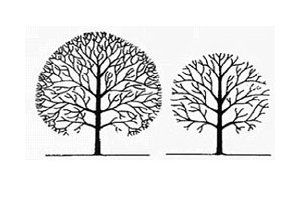Call us: 07884 380 406
Types of Tree Surgery

Types of Tree Surgery
Please bear in mind that the information provided here is not exhaustive, so if you need advice make use of our free no obligation quotations contact
your local tree surgeon today.

Crown Reduction
This process involves reducing the size of the trees' overall canopy by pruning the branches evenly throughout the crown. Dangerous deadwood and crossing branches are removed or pruned during the process to minimize the possibility of pathogens and disease infecting the tree.

Crown Lifting
Crown Lifting is the removal of selected branches and limbs from the lower part of the trees crown. This lifts the crown's overall height and allows more light to penetrate through the lower crown.
Felling
Occasionally a tree may need to be removed completely. Felling a large tree in a restricted area will normally require the tree to be climbed and dismantled in sections. Other times, when space, safety and the trees form allow, a tree may be felled in the traditional forestry sense of the term. This involves bringing the tree to the ground using practised methods to ensure a safe, controlled and calculated fell.
Stump & Root Removal
Once a tree has been felled to ground level, you may require the stump to also be removed. For this we offer a straight forward stump and root removal service. This procedure involves using a stump grinding machine that will grind the stump out of the ground until the stump and root system are destroyed. If the stump presence is not a concern, we will treat the stump to ensure that re-growth does not occur.
Hedge Trimming & Reduction
Regular hedge trimming maintains the hedge to look 'tight and full' and can avoid the need to cut back heavily. If left neglected, cutting back heavily can result in a bare and unpleasant looking hedge-line, which may take some time to fully recover. Hedge maintenance may also include the reduction in hedge height when left neglected and overgrown.
Pollarding
Pollarding is a woodland management method, but has in recent years found its way into the practice of arboriculture. The process involves the removal of all branches and most limbs, resulting in the remainder of only the trunk and occasionally a framework of the major limbs. After a tree has been pollarded the tree is given some time to re-grow, after which the process may be repeated.
Branch & Limb Removal
Sometimes it is necessary to remove certain branches of a trees crown, without fully reducing, thinning or lifting the crown. An example would be if a large branch or number of branches had extended over a neighbouring boundary. This process involves removing as little live growth as possible to ensure the health and stability of the tree.
Deadwooding
As a tree grows it is natural for some branches to die back, for safety reasons it is advisable to have your tree regularly inspected and cleared of any deadwood especially in public areas.
We believe we can remove any tree from any location without causing any damage. This can be through houses or garages if no access to a back garden is available.
We have been known to take trees down that have been growing out of rock faces. Telephone line avoidance is a speciality of ours.
We are prepared to work on trees that are near power cables and we are happy to liaise with energy providers to get the power shut off to ensure a safe working area.
If trees are overhanging roads or the only place to set up is on the road, permission to use the road can be sought from the council highway department and traffic management systems can be arranged.
We can also assist you in the completion of application forms for work on trees that are in conservation areas or trees with preservation orders on them.
Where there may not be room to fell the tree at ground level we can climb the tree and dismantle it piece by piece. Where a drop zone is not available we can use a technique called rigging to safely lower each piece of tree to the ground and place the section exactly where we feel it is safe to do so.
Thank you for taking the time to read about us and some of our most popular types of tree surgery. Please do not hesitate to contact us at any time. Our quotations are free of charge with no obligation.
© 2024. The content on this website is owned by us and our licensors. Do not copy any content (including images) without our consent.
